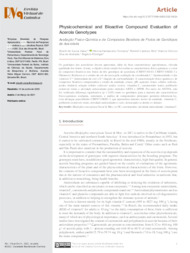Initial production and fruit quality of scion-rootstock combinations in orange trees in Amazonas.
Initial production and fruit quality of scion-rootstock combinations in orange trees in Amazonas.
Author(s): SANTOS, J. C.; AZEVEDO, C. L. L.; CARVALHO, J. E. B. de; OLIVEIRA, S. P. de; FERREIRA, A. de S.; SILVA, J. da
Summary: The cultivation of orange trees in Amazonas, Brazil relies predominantly on grafted plants combining ?Pera? scion and ?Rangpur? lime rootstock. Alternative rootstocks better adapted to the conditions of the region have not been investigated. Therefore, the objective of this research was to test seven rootstocks for the production of high-quality oranges under the typical conditions of the Amazon. Citrus production was evaluated from May to August between 2017 and 2019, based on the variables of cumulative yield, yield efficiency, and crop-yield index over the study period. The fruit physicochemical quality was evaluated by quantification of total soluble solids, total titratable acidity, ratio, juice percentage, and technological index. ?Indio,? ?BRS Bravo?, and ?Riverside? genotypes combined with ?Pera?/CNPMF scion had the highest yield and good fruit quality. They are potentially the most suitable combinations to grow sweet oranges in the Amazon. Index Terms: orange trees, Amazon, rootstocks, initial production, quality.
Publication year: 2021
Types of publication: Journal article
Unit: Embrapa Cassava & Fruits
Keywords: Laranja, Porta Enxerto
Observation
Some of Embrapa's publications are published as ePub files. To read them, use or download one of the following free software options to your computer or mobile device. Android: Google Play Books; IOS: iBooks; Windows and Linux: Calibre.
Access other publications
Access the Agricultural Research Database (BDPA) to consult Embrapa's full library collection and records.
Visit Embrapa Bookstore to purchase books and other publications sold by Embrapa.

